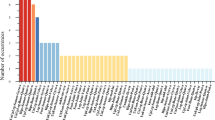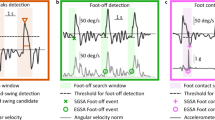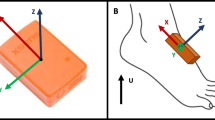Abstract
Due to the technological advances of micro-electro-mechanical sensor and wireless sensor network, gait analysis has been widely adopted as an significant indicator of mobility impairment for stroke survivors. This paper aims to propose an wearable computing based gait impairment evaluation method with distribute inertial sensor unit (IMU) mounted on human lower limbs. Temporal-spacial gait metrics were evaluated on more than twenty post stroke patients and ten healthy control subjects in the 10-meters-walk-test. Experimental results shown that significant differences exist between stroke patients and healthy subject in terms of various gait metrics. The extracted gait metrics are consistent with clinical observations, and the position estimation accuracy has been validated by optical device. The proposed method has the potential to serve as an objective and cost-efficient tool for rehabilitation-assisting therapy for post stroke survivors in clinical practice.
Access this chapter
Tax calculation will be finalised at checkout
Purchases are for personal use only
Similar content being viewed by others
References
Gravina, R., Alinia, P., Ghasemzadeh, H., Fortino, G.: Multi-sensor fusion in body sensor networks: state-of-the-art and research challenges. Inf. Fusion 35, 68–80 (2016)
Fortino, G., Galzarano, S., Gravina, R., Li, W.: A framework for collaborative computing and multi-sensor data fusion in body sensor networks. Inf. Fusion 22, 50–70 (2015)
Horak, F.B., King, L., Mancini, M.: Role of body-worn movement monitor technology for balance and gait rehabilitation. Phys. Ther. 95(3), 461–70 (2015)
Gravina, R., et al.: Cloud-based activity-aaservice cyber-physical framework for human activity monitoring in mobility. Future Gener. Comput. Syst. 75, 158–171 (2017)
Qiu, S., Wang, Z., Zhao, H., Liu, L., Jiang, Y., Li, J.: Body sensor network based robust gait analysis: toward clinical and at home use. IEEE Sens. J. 19, 1–9 (2019)
Al-Amri, M., Nicholas, K., Button, K., Sparkes, V., Sheeran, L., Davies, J.L.: Inertial measurement units for clinical movement analysis: reliability and concurrent validity. Sens. (Switz.) 18(3), 1–29 (2018)
Kumar, P., Mukherjee, S., Saini, R., Kaushik, P., Roy, P.P., Dogra, D.P.: Multimodal gait recognition with inertial sensor data and video using evolutionary algorithm. IEEE Trans. Fuzzy Syst. 27(5), 956–965 (2019)
Qiu, S., Wang, Z., Zhao, H., Liu, L., Jiang, Y.: Using body-worn sensors for preliminary rehabilitation assessment in stroke victims with gait impairment. IEEE Access 6, 31249–31258 (2018)
Wang, Q., Markopoulos, P., Yu, B., Chen, W., Timmermans, A.: Interactive wearable systems for upper body rehabilitation: a systematic review. J. NeuroEngineering Rehabil. 14, 1–21 (2017)
Baghdadi, A., Cavuoto, L.A., Crassidis, J.L.: Hip and trunk kinematics estimation in gait through Kalman Filter using IMU data at the Ankle. IEEE Sens. J. 18(10), 4253–4260 (2018)
Leal-Junior, A.G., Frizera, A., Avellar, L.M., Marques, C., Pontes, M.J.: Polymer optical fiber for in-shoe monitoring of ground reaction forces during the gait. IEEE Sens. J. 18(6), 2362–2368 (2018)
Lu, R., Lin, X., Liang, X., Shen, X.: A secure handshake scheme with symptoms-matching for mHealthcare social network. Mob. Netw. Appl. 16(6), 683–694 (2011)
Qiu, S., Liu, L., Zhao, H., Wang, Z., Jiang, Y.: MEMS inertial sensors based gait analysis for rehabilitation assessment via multi-sensor fusion. Micromachines 9(9), 442 (2018)
Wang, Z., et al.: Using wearable sensors to capture posture of the human lumbar spine in competitive swimming. IEEE Trans. Hum.-Mach. Syst. 49(2), 194–205 (2019)
Majumder, S., Mondal, T., Deen, M.J.: A simple, low-cost and efficient gait analyzer for wearable healthcare applications. IEEE Sens. J. 19(6), 2320–2329 (2019)
Favre, J., Jolles, B., Siegrist, O., Aminian, K.: Quaternion-based fusion of gyroscopes and accelerometers to improve 3D angle measurement. Electron. Lett. 42(11), 3–4 (2006)
Zhao, H., Wang, Z., Qiu, S., Shen, Y., Zhang, L., Tang, K.: Heading drift reduction for foot-mounted inertial navigation system via multi-sensor fusion and dual-gait analysis. IEEE Sens. J. 19(19), 8514–8521 (2019)
Gouwanda, D., Gopalai, A.A., Khoo, B.H.: A low cost alternative to monitor human gait temporal parameters-wearable wireless gyroscope. IEEE Sens. J. 16(24), 9029–9035 (2016)
Ahmed, M., Naude, J., Birkholtz, F., Glatt, V., Tetsworth, K.: Gait & Posture the relationship between gait and functional outcomes in patients treated with circular external fi xation for malunited tibial fractures. Gait Posture 68, 569–574 (2019)
Qiu, S., Wang, Z., Zhao, H., Qin, K., Li, Z., Hu, H.: Inertial/magnetic sensors based pedestrian dead reckoning by means of multi-sensor fusion. Inf. Fusion 39, 108–119 (2018)
Huang, H., et al.: Attitude estimation fusing quasi-newton and cubature Kalman filtering for inertial navigation system aided with magnetic sensors. IEEE Access 6, 28755–28767 (2018)
Gheorghe, M.V., Member, S., Bodea, M.C., Member, L.S.: Calibration optimization study for tilt-compensated compasses. IEEE Trans. Instrum. Meas. 67(6), 1486–1494 (2018)
Choe, N., Zhao, H., Qiu, S., So, Y.: A sensor-to-segment calibration method for motion capture system based on low cost MIMU. Measurement 131, 490–500 (2018)
Zhao, H., Wang, Z., Qiu, S.: Adaptive gait detection based on foot-mounted inertial sensors and multi-sensor fusion. Inf. Fusion 52, 157–166 (2019)
Qiu, S., Wang, Z., Zhao, H., Hu, H.: Using distributed wearable sensors to measure and evaluate human lower limb motions. IEEE Trans. Instrum. Meas. 65(4), 939–950 (2016)
Wang, Z., et al.: Inertial sensor-based analysis of equestrian sports between beginner and professional riders under. IEEE Trans. Instrum. Meas. 67(11), 2692–2704 (2018)
An, W.W., et al.: Neurophysiological correlates of gait retraining with real-time visual and auditory feedback. IEEE Trans. Neural Syst. Rehabil. Eng. 27(6), 1341–1349 (2019)
Acknowledgments
This research was funded by National Natural Science Foundation of China (61803072, 61873044 and 61903062), China Postdoctoral Science Foundation (2017M621131 and 2017M621132), Liaoning Natural Science Foundation Key Project no. 20180540011, Dalian Science and Technology Innovation fund (2019J13SN99 and 2018J12SN077), Fundamental Research Funds for the Central Universities no. DUT18RC(4)034, and National Defence Pre-research Foundation no. 614250607011708.
Author information
Authors and Affiliations
Corresponding author
Editor information
Editors and Affiliations
Rights and permissions
Copyright information
© 2019 ICST Institute for Computer Sciences, Social Informatics and Telecommunications Engineering
About this paper
Cite this paper
Qiu, S., Guo, X., Zhao, H., Wang, Z., Li, Q., Gravina, R. (2019). Towards Body Sensor Network Based Gait Abnormality Evaluation for Stroke Survivors. In: Mucchi, L., Hämäläinen, M., Jayousi, S., Morosi, S. (eds) Body Area Networks: Smart IoT and Big Data for Intelligent Health Management. BODYNETS 2019. Lecture Notes of the Institute for Computer Sciences, Social Informatics and Telecommunications Engineering, vol 297. Springer, Cham. https://doi.org/10.1007/978-3-030-34833-5_9
Download citation
DOI: https://doi.org/10.1007/978-3-030-34833-5_9
Published:
Publisher Name: Springer, Cham
Print ISBN: 978-3-030-34832-8
Online ISBN: 978-3-030-34833-5
eBook Packages: Computer ScienceComputer Science (R0)




